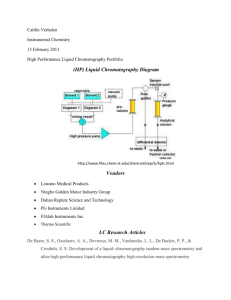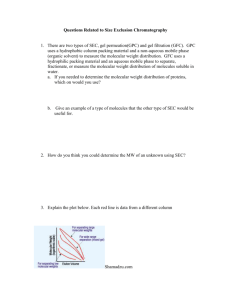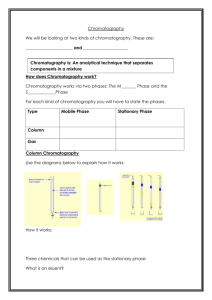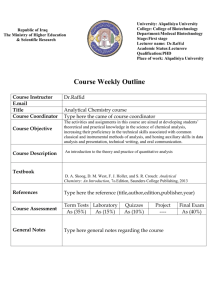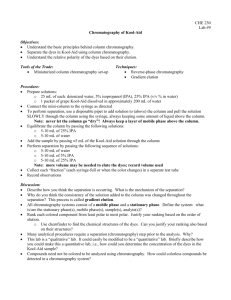Modul 4
advertisement
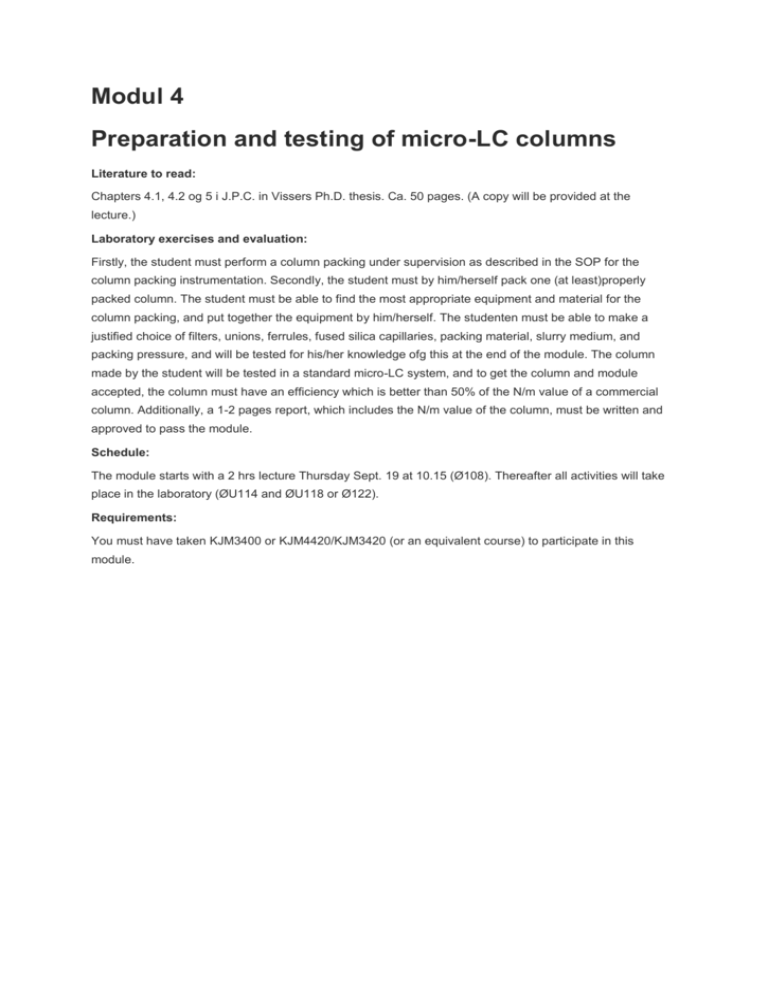
Modul 4 Preparation and testing of micro-LC columns Literature to read: Chapters 4.1, 4.2 og 5 i J.P.C. in Vissers Ph.D. thesis. Ca. 50 pages. (A copy will be provided at the lecture.) Laboratory exercises and evaluation: Firstly, the student must perform a column packing under supervision as described in the SOP for the column packing instrumentation. Secondly, the student must by him/herself pack one (at least)properly packed column. The student must be able to find the most appropriate equipment and material for the column packing, and put together the equipment by him/herself. The studenten must be able to make a justified choice of filters, unions, ferrules, fused silica capillaries, packing material, slurry medium, and packing pressure, and will be tested for his/her knowledge ofg this at the end of the module. The column made by the student will be tested in a standard micro-LC system, and to get the column and module accepted, the column must have an efficiency which is better than 50% of the N/m value of a commercial column. Additionally, a 1-2 pages report, which includes the N/m value of the column, must be written and approved to pass the module. Schedule: The module starts with a 2 hrs lecture Thursday Sept. 19 at 10.15 (Ø108). Thereafter all activities will take place in the laboratory (ØU114 and ØU118 or Ø122). Requirements: You must have taken KJM3400 or KJM4420/KJM3420 (or an equivalent course) to participate in this module. Modul 7 Micro-LC-UV Literature to read: The following articles must be read: Vissers, Johannes P. C.; A. Claessens, Henk; Cramers, Carel A. Microcolumn liquid chromatography: instrumentation, detection and applications. Journal of Chromatography A (1997), 779(1 + 2), 1-28. Vissers, J. P. C. Recent developments in microcolumn liquid chromatography. Journal of Chromatography A (1999), 856(1 + 2), 117-143 Chervet, J. P.; Ursem, M.; Salzmann, J. P. Instrumental Requirements for Nanoscale Liquid Chromatography. Analytical Chemistry (1996), 68(9), 1507-1512 Laboratory exercises and evaluation: The studenten will use a micro-LC system consisting of a pump with a solvent reservoir, a micro injector, a micro column and a UV detector with ”on-capillary” flow cell. Firstly, the system must be tested with a test mixture which is provided. Totalchrom software will be used for data collection. Secondly, a new test mixture will be provided to the student who must develop an analysis method for separation of the compounds in the test mixture. To get the module accepted the student must find the separation conditions and perform the separation. The student must obtain enough knowledge of the Totalchrom software to be able to store chromatograms, to reanalyse chromatograms and to transfer the chromatograms to Word documents. Chromatogram(s) showing sufficient separation must be presented in the written report. At the end of the module, the student will be examined with regard to choosing capillary dimensions, mobile phases, mobile phase flow rates, sample volumes etc., and in the knowledge of the chromatography software used. The student is expected to know the subject to the extent that he/she is able to make new methods, to save, reanalyse and transfer chromatograms to Word documents. Additionally, a 1-2 pages report must be written and approved to pass the module. Schedule: The module starts with a 2 hrs lecture Thursday Oct. 4 at 10.15 (Ø108). Thereafter, all activities will take place in the laboratory (ØU118 or Ø122). Requirements: You must have taken KJM3400 or KJM4420/KJM3420 (or an equivalent course) to participate in this module. Modul 11 Micro-LC column-switching systems Literature to read: Evans, Charles R.; Jorgenson, James W.. Multidimensional LC-LC and LC-CE for high-resolution separations of biological molecules. Analytical and Bioanalytical Chemistry (2004), 378, 1952-1957(NB) Pitarch, Elena; Hernandez, Felix; ten Hove, Jan; Meiring, Hugo; Niesing, Willem; Dijkman, Ellen; Stolker, Linda; Hogendoorn, Elbert. Potential of capillary-column-switching liquid chromatography-tandem mass spectrometry for the quantitative trace analysis of small molecules. Application to the on-line screening of drugs in water. Journal of Chromatography, A (2004), 1031, 1-9 Holm,A; Large volume injection in capillary LC (part of PhD thesis 2004) - a copy will be provided at the lecture. Holm, A.; Molander, P.; Lundanes, E.; Greibrokk, T. Determination of rotenone in river water utilizing packed capillary column switching liquid chromatography with UV and time-of-flight mass spectrometric detection. Journal of Chromatography, A (2003), 983, 43-50. Holm, Anders; Molander, Paal; Lundanes, Elsa; Ovrebo, Steinar; Greibrokk, Tyge. Fast and sensitive determination of urinary 1-hydroxypyrene by packed capillary column switching liquid chromatography coupled to micro-electrospray time-of-flight mass spectrometry. Journal of Chromatography, B: Analytical Technologies in the Biomedical and Life Sciences (2003), 794, 175-183. Holm, Anders; Solbu, Kasper; Molander, Paal; Lundanes, Elsa; Greibrokk, Tyge. Sensitive biomonitoring of phthalate metabolites in human urine using packed capillary column switching liquid chromatography coupled to electrospray ionization ion-trap mass spectrometry. Analytical and Bioanalytical Chemistry (2004), 378, 1762-1768. Laboratory exercises and evaluation: The supervisor will show the student the set-up of a micro column switching with UV deteksjon. The student will under supervison test the system using a test mixture of compounds and the conditions provided by the supervisor (method 1). Thereafter, the student is given a new test mixture, and the student must find the appropriate conditons to focus the componds on the precolumn and separate the compounds on the analytical column. To pass the module, the student must show that the method can be used to inject up to 500 µL without breakthrough and without loss in efficiency (compared with the efficiency found in method 1). The repeatability of retention times and peak area must be better than 3% RSD (n > 3). At the end of the module, the student will be examined with regard to choosing capillary dimensions, stationary phases, mobile phases and injection volume and other theoretical subjects, to control that the student can relate theoretical and practical knowledge. Additionally, a 1-2 pages report must be written and approved to pass the module. Schedule: The module starts with a 2 hrs lecture Thursday Oct. 17 at 10.15 (Ø108). Thereafter, all activites will take place in the laboratory (ØU118 or Ø122). Requirements: You must have taken KJM3400 or KJM4420/KJM3420 (or an equivalent course) to participate in this module. To be able to take this module, you must have taken module no. 7. Modul 15 Micro-LC-MS Literature to read: Chapter. 3 (Fundamental mass spectrometry) in the book "Protein sequencing and identification using tandem mass spectrometry" by Michael Kinter og Nicholas E. Sherman, Wiley, 2000. Abian, J.; Oosterkamp, A. J.; Gelpi, E. Comparison of conventional, narrow-bore and capillary liquid chromatography/mass spectrometry for electrospray ionization mass spectrometry: practical considerations. Journal of Mass Spectrometry (1999), 34, 244-254 Zimmer, D.. Introduction to quantitative liquid chromatography-tandem mass spectrometry (LC-MS-MS). Chromatographia (2003), 57(Suppl.), S/325-S/332. Capiello, A., Famiglini, G., Palma P., Trufelli, H. Matrix effects in liquid chromatography-mass spectrometry. Journal of Liquid Chromatography & Related Technologies (2010), 33, 1067-1081. Additionally you may have a look at: Smyth, W. Franklin; Brooks, Peter. A critical evaluation of high performance liquid chromatographyelectrospray ionisation-mass spectrometry and capillary electrophoresis-electrospray-mass spectrometry for the detection and determination of small molecules of significance in clinical and forensic science. Electrophoresis (2004), 25(10-11), 1413-1446. Laboratory exercises and evaluation: The supervisor will show and explain the features of the micro-LC system coupled to an electrospray MS instrument (TOF instrument). Introduction to MassLynx software,and washing and maintenance of ESI, will be given. Thereafter the student must make a gradient method, which separates the compounds and give good response in the MS, for determination of test compounds which are provided. To pass the module the student must show TIC and RIC chromatograms of the separation and mass spectra of the compounds provided. At the end of the module, the student will be examined with regard to choosing mobile phases and MS parameters, and in the knowledge of the MS instrument and ability to transfer data to Word documents. Additionally, a 1-2 pages report must be written and approved to pass the module. Schedule: The module starts with a 2 hrs lecture Thursday Oct. 31 at 10.15 (Ø108). Thereafter, all activites will take place in the laboratory (Ø122). Requirements: You must have taken KJM3400 or KJM4420/KJM3420 (or an equivalent course) to participate in this module. To be able to take this module, you must also have taken module no. 7.


